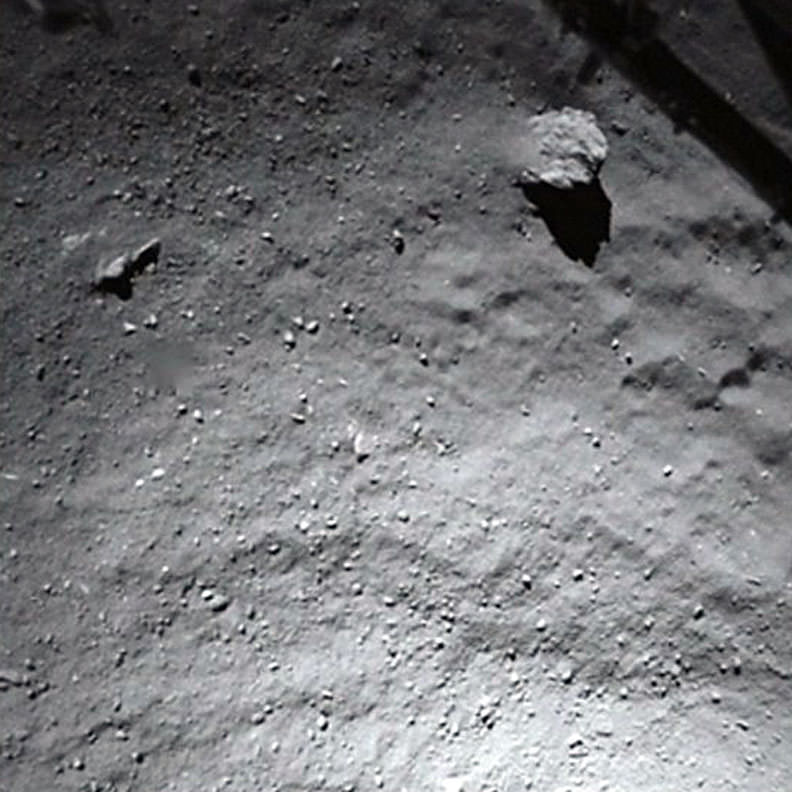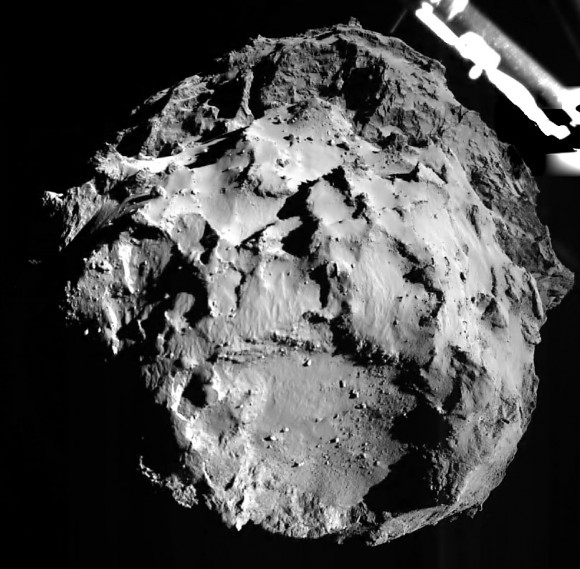

Image from the Philae lander as it approached the surface. The dust-covered boulder at upper right is about 5 meters (16.4 feet) across. The dust might have originated through vaporization of ice on the boulder itself or deposited there by dust settling from jets elsewhere. Credit: ESA


Hey, we’re getting closer! This photo was taken by Philae’s ROLIS instrument just 1.8 miles (3 km) above the surface of 67P/Churyumov-Gerasimenko at 8:38 a.m. (CST) today. The ROLIS instrument is a down-looking imager that acquires images during the descent and doubles as a multi-wavelength close-up camera after the landing. The aim of the ROLIS experiment is to study the texture and microstructure of the comet’s surface. ROLIS (ROsetta Lander Imaging System) is a descent and close-up camera on the Philae lander.
I know, I know. You got a fever for more comet images the way Christopher Walken on Saturday Night Live couldn’t get enough cowbell.
Key scientists in a media briefing this afternoon highlighted the good news and the bad news about the landing. We reported earlier that both the harpoons and top thrusters failed to fire and anchor the lander to the comet. Yet land it did – maybe more than once! A close study of the data returned seems to indicate that Philae, without its anchors, may have touched the surface and then lifted off again, turning itself from the residual angular momentum left over after its flywheel was shut down. Stephan Ulamec, Philae Landing Manager, got a appreciative laugh from the crowd when he explained it this way: Maybe today we didn’t just land once. We landed twice!”
Telemetry from the probe has been sporadic. Data streams come in strong and then suddenly cut out only to return later. These fluctuations in the radio link obviously have the scientists concerned and as yet, there’s no explanation for them. Otherwise, Philae landed in splendid fashion almost directly at the center of its planned “error ellipse”.
Instruments on Philae are functioning normally and gathering data as you read this. Ulamec summed up the situation nicely: “It’s complicated to land and also complicated to understand the landing.”
Scientists and mission control will work to hopefully resolve the harpoon and radio link issues. The next live webcast begins tomorrow starting at 7 a.m. (CST). Although nothing definite was said, we may see more images arriving still today, so stop by later.
Hypervelocity stars have been seen before but NASA scientists have just identified a potential record-breaking…
Finding alien life may have just got easier! If life does exist on other worlds…
MSL Curiosity is primarily a rockhound. It's at Gale Crater, examining the rocks there and…
Venus is very variable. Its surface constantly changes from volcanic activity, and the difference between…
Hydrogel protection could be crucial for safe human space exploration. It’s a key problem that…
When massive stars reach the end of their life cycle, they undergo gravitational collapse and…